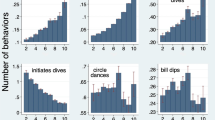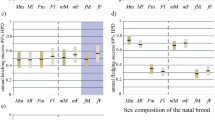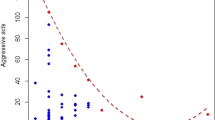Abstract
According to the desperado sibling hypothesis, chicks of obligately siblicidal species kill their junior broodmates as early as possible because junior broodmates face dire ecological prospects and are consequently predisposed to aggressively overthrow elder broodmates by all-out aggression. The agonistic behavior of junior chicks is virtually unknown because they die so young. We investigated the agonistic behavior of hypothetical desperados by fostering junior brown boobies (Sula leucogaster, an obligately siblicidal species) into nests of the blue-footed booby (S. nebouxii, a facultatively siblicidal species) containing an older singleton blue-foot chick. Controls were junior blue-footed boobies fostered into the same situation. Junior brown boobies were 7 times more aggressive than controls and most of them dominated their elder and larger nestmates. Four of nine brown booby juniors showed relentless aggression, delivering up to 711 pecks, bites and pushes (including "expulsion pushes") per hour, thereby overwhelming nestmates 90% heavier and permanently expelling one of them from the nest. Similarly, in natural broods of two surviving brown booby chicks, the losing chick was 13 times as aggressive as blue-foot subordinates, up to at least age 7 weeks. Contrast of the two species of booby suggests the evolution of agonistic roles within broods may be partly driven by selection on potential victims to express a level and type of aggressiveness appropriate to their status-related ecological prospects.




Similar content being viewed by others
References
Amerson BA, Shelton PC (1976) The natural history of Johnston Atoll, Central Pacific Ocean. Atoll Res Bull 192:213–235
Anderson DJ (1989) The role of hatching asynchrony in siblicidal brood reduction of two booby species. Behav Ecol Sociobiol 25:363–368
Anderson DJ (1990) Evolution of obligate siblicide in boobies. II Food limitation and parent-offspring conflict. Evolution 44:2069–2082
Anderson DJ, Ricklefs RE (1995) Evidence of kin-selected tolerance by nestlings in a siblicidal bird. Behav Ecol Sociobiol 37:163–168
Bortolotti GR (1986) Evolution of growth rates in eagles: sibling competition vs energy considerations. Ecology 67:182–194
Cash KJ, Evans RM (1986) Brood reduction in the American white pelican (Pelecanus erythrorhynchos). Behav Ecol Sociobiol 18:413–418
Castillo A, Chavez-Peón C (1983) Ecología Reproductiva e influencia del comportamiento en el control del número de crias en el bobo de patas azules, Sula nebouxii, en la Isla Isabel, Nay. Undergraduate thesis, Facultad de Ciencias UNAM
Clifford LD, Anderson DJ (2001) Experimental demonstration of the insurance value of extra eggs in an obligately siblicidal seabird. Behav Ecol 12:340–347
Cohen-Fernández EJ (1988) La reducción de la nidada en el bobo café (Sula leucogaster nesiotes Heller and Snodgrass 1901). Undergraduate thesis, Facultad de Ciencias, Universidad Nacional Autónoma de México
Creighton JC, Schnell GD (1996) Proximate control of siblicide in cattle egrets: a test of the food amount hypothesis. Behav Ecol Sociobiol 38: 371–377
Dorward EF (1962) Comparative biology of the white booby and brown booby, Sula spp. at Ascension. Ibis 103b:174–220
Drummond H (1993) Have avian parents lost control of offspring aggression? Etología 3:187–198
Drummond H (2001a) The control and function of agonism in avian broodmates. In: Slater PJB, Rosenblatt JS, Snowdon CT, Roper TJ (eds) Advances in the study of the behavior, vol. 30. Academic Press, New York, pp 261–301
Drummond H (2001b) A revaluation of the role of food in nestling aggression. Anim Behav 61:1–10
Drummond H, Canales C (1998) Dominance between booby nestlings involves winner and loser effects. Anim Behav 55:1669–1676
Drummond H, García Chavelas C (1989) Food shortage influences sibling aggresion in the blue-footed booby. Anim Behav 37:806–819
Drummond H, Osorno JL (1992) Training siblings to be submissive losers: dominance between booby nestlings. Anim Behav 44:881–893
Drummond H, Gonzalez E, Osorno JL (1986) Parent-offspring cooperation in the blue-footed booby (Sula nebouxii): social roles in infanticidal brood reduction. Behav Ecol Sociobiol 19:365–372
Drummond H, Osorno JL, García C, Torres R, Merchant H (1991) Sexual dimorphism and sibling competition: implications for avian sex ratios. Am Nat 138:623–641
Evans RM (1996) Hatching asynchrony and survival of insurance offspring in an obligate brood-reducing species, the American white pelican. Behav Ecol Sociobiol 39:203–209
Evans RM (1997) Parental investment and quality of insurance offspring in an obligate brood-reducing species, the American white pelican. Behav Ecol 8:378–383
Evans RM, McMahon BF (1987) Within-brood variation in growth and condition in relation to brood reduction in the American white pelican. Wilson Bull 99:190–201
Forbes LS (1990) Insurance offspring and the evolution of avian clutch size. J Theor Biol 147:345–359
Forbes LS (1991) Insurance offspring and brood reduction in a variable environment: the costs and benefits of pessimism. Oikos 62:325–332
Forbes LS, Mock DW (1996) Food, information and avian brood reduction. Ecoscience 3:45–53
Forbes LS, Mock DW (1998) Parental optimism and progeny choice: When is screening for offspring quality affordable? J Theor Biol 192:3–14
Forbes LS, Ydenberg RC (1992) Sibling rivalry in a variable environment. Theor Popul Biol 41:335–360
Fujioka M (1985) Sibling competition and siblicide in asynchronously hatching broods of the cattle egret Bubulcus ibis. Anim Behav 33:1228–1242
Gargett V (1978) Sibling aggression in the black eagle in the Matopos, Rhodesia. Ostrich 49:57–63
Gerhardt RP, Gerhardt DM, Vásquez MA (1997) Siblicide in Swallow-tailed Kites. Wilson Bull 109:112–120
Godfray HCJ, Harper AB (1990). The evolution of brood reduction by siblicide in birds. J Theor Biol 145:163–175
Grafen A (1987) The logic of divisively asymmetric contests: respect for ownership and the desperado effect. Anim Behav 35:462–467
Hollander M, Wolfe DA (1999) Nonparametric statistical methods. Wiley, New York
Kasuya E (2001) Mann-Whitney U test when variances are unequal. Anim Behav 61:1247–1249
Kepler CB (1969) Breeding biology of the blue-faced booby Sula dactylatra personata on Green Island, Kure Atoll. Publ Nuttall Ornithol Club 8:1–97
Meyburg BU (1977) Sibling aggression and cross-fostering of eagles. In: Temple SA (ed) Endangered birds. University of Wisconsin Press, Madison, pp 195–201
Mock DW (1984) Infanticide, siblicide and avian nestling mortality. In: Hausfater G, Hrdy SB, (eds) Infanticide: comparative and evolutionary perspectives. Aldine, New York, pp 2–31
Mock DW, Forbes LS (1995) The evolution of parental optimism. Trends Ecol Evol 10:130–134
Mock DW, Lamey TC (1991) The role of brood size in regulating egret sibling aggression. Am Nat 138:1015–1026
Mock DW, Parker GA (1986) Advantages and disadvantages of ardeid brood reduction. Evolution 40:459–470
Mock DW, Parker GA (1997) The evolution of sibling rivalry. Oxford University Press, Oxford
Nelson JB (1978) The Sulidae: gannets and boobies. Oxford University Press, London
Nuechterlein GL (1981) Asynchronous hatching and sibling competition in western grebe broods. Can J Zool 59:994–998
O'Connor RJ (1978) Brood reduction in birds: selection for fratricide, infanticide, and suicide. Anim Behav 26:79–96
Ploger BJ, DW Mock (1986) Role of sibling aggression in distribution of food to nestling cattle egrets (Bubulcus ibis). Auk 103:768–776
Ricklefs RE (1982) Some considerations on sibling competition and avian growth rates. Auk 99:141–147
Simmons R (1988) Offspring quality and the evolution of cainism. Ibis 130:339–357
Stinson CH (1979) On the selective advantage of fratricide in raptors. Evolution 33:1219–1225
Tershey BR, Breese D, Croll DA (2000) Insurance eggs versus additional eggs: do brown boobies practice obligate siblicide? Auk 117:817–820
Trivers RL (1974) Parent-offspring conflict. Am Zool 14:249–264
Werschkul DF, Jackson JA (1979) Sibling competition and avian growth rates. Ibis 121:97–102
Woodward PW (1972) The natural history of Kure Atoll, Northwestern Hawaiian Islands. Atoll Res Bull 164:1–318
Acknowledgements
This research was financed by CONACYT grant 31973 and the UNAM. We are very grateful to Dave Anderson, Scott Forbes, Alejandro Gonzalez, Barb Glassey, Regina Macedo, Doug Mock and José Luis Osorno for comments on the manuscript; the Mexican Navy for logistical support; Bernie Tershey for advice on the logistics and boobies of San Pedro Mártir; Jaime Zaldivar for drawing Fig. 2; and Prescott College for logistical advice and support. The experiment and observations were authorized by the Secretaría del Medioambiente y Recursos Naturales and carried out in accordance with Mexican law and the ABS/ASAB Guidelines for the Use of Animals in Research.
Author information
Authors and Affiliations
Corresponding author
Additional information
Communicated by C. Brown
Rights and permissions
About this article
Cite this article
Drummond, H., Rodríguez, C., Vallarino, A. et al. Desperado siblings: uncontrollably aggressive junior chicks. Behav Ecol Sociobiol 53, 287–296 (2003). https://doi.org/10.1007/s00265-002-0571-2
Received:
Revised:
Accepted:
Published:
Issue Date:
DOI: https://doi.org/10.1007/s00265-002-0571-2




